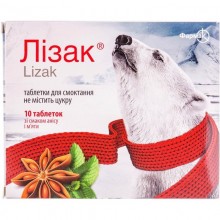



 Secure and encrypted payment processing
Secure and encrypted payment processing We ship to over 40 countries including the USA, UK, Europe, Australia and Japan
We ship to over 40 countries including the USA, UK, Europe, Australia and Japan Guaranteed refund or reship if you haven't received your order
Guaranteed refund or reship if you haven't received your orderLisac is a combined preparation with a well-defined local antiseptic, antibacterial and antifungal effect. The therapeutic effect of the drug is due to its components.
Dequalinium chloride - a local antiseptic of the quinoline group, has an antiseptic effect - mainly local; antibacterial action - mainly relative to gram-positive and gram-negative microorganisms; antifungal effect - mainly against Candida albicans, some species of Trychophyton and epidermophytes.
The antibacterial effect is due to the denaturation of proteins and enzymes of the pathogen by dissolution and depolymerization, as well as glycolysis and inactivation of dehydrogenases; impaired protein synthesis at the level of ribosomes; cell membrane cytolysis. The surface-active cationic effect underlies its bacteriostatic activity, which is stronger in relation to gram-positive than to gram-negative microorganisms.
Lysozyme is a mucopolysaccharide effective against gram-positive bacteria due to the conversion of insoluble polysaccharides of the cell wall into soluble mucopeptides. It is also effective against gram-negative bacteria, viruses, and fungi.
Lysozyme has a local anti-inflammatory effect and increases the nonspecific defense of the body.
Pharmacokinetics Dequalinium chloride is absorbed in very small quantities.
Lysozyme is well absorbed from the digestive tract. Cmax Lysozyme in the blood is reached after 1-1.5 hours. Lysozyme is widely distributed in the tissues of the body, especially accumulates in the mucous membranes. Hydrolyzed by intestinal enzymes, excreted in the form of a metabolite in the urine.
Local antiseptic treatment of the inflammatory processes of the oral cavity and throat caused by drug-sensitive pathogens (catarrhal, ulcerative, fibrous gingivitis; aphthous stomatitis; candidiasis of the oral cavity and pharynx; pharyngitis; tonsillitis; laryngitis and glossitis), prevention of infections before and after surgical interventions in the cavity mouth and throat.
Recommended doses for adults and children over 12 years old. apply 1 tablet for resorption every 2-3 hours (no more than 10 tablets per day). after reducing the severity of the symptoms of inflammation - 1 tablet every 4 hours.
Recommended doses for children aged 4 to 12 years. Use 1 tablet for resorption every 3 hours (no more than 5 tablets per day). After reducing the severity of the symptoms of inflammation, 1 tablet every 4 hours.
The tablet should be absorbed slowly, without chewing.
After using the drug, it is recommended not to eat or drink for 30 minutes.
Treatment is recommended to continue for another 1-2 days after the disappearance of the symptoms of the disease. It is recommended to use Lysac until the symptoms of the disease disappear. If the symptoms do not disappear after 5-7 days of treatment, you should consult a doctor to determine further treatment tactics.
Hypersensitivity to active substances or any of the auxiliary components of the drug, allergy to quaternary ammonium compounds (e.g. benzalkonium chloride).
The following adverse reactions are possible:
from the gastrointestinal tract: nausea, dry mouth, dysbiosis of the oral cavity (with prolonged use in high doses);
on the part of the skin and subcutaneous tissue: allergic reactions are possible, including urticaria, rash, itching;
local reactions, including a burning sensation and irritation in the throat and mucous membrane of the oral cavity. In rare cases, namely with abuse, ulcers and necrosis may occur.If any adverse reactions develop, the use of the drug should be discontinued and it is imperative to consult a doctor regarding further therapy.
Anise and peppermint flavored tablets do not contain sugar, so they can be used in patients with diabetes.
1 lozenges tablet with chocolate, orange or raspberry flavors contains 0.05 XE, which must be considered for patients with diabetes mellitus.
In the presence of the main clinical symptoms of generalization of the infection, systemic antibiotic treatment should be prescribed. If any side effects occur, you must stop taking Lisac and prescribe another drug.
Use with other drugs at the same time for local treatment with caution.
Anise and peppermint flavored tablets contain lactose, so patients with rare hereditary forms of galactose intolerance, lactase deficiency or glucose-galactose malabsorption syndrome should not use them.
Use during pregnancy and lactation. No controlled studies have been conducted. In this regard, the drug during pregnancy or lactation can be used after consulting a doctor if the therapeutic effect exceeds the possible risk of exposure to the fetus / child.
Children. The drug in this dosage form should not be used to treat children under 4 years of age because of the risk of aspiration.
The ability to influence the reaction rate when driving vehicles or working with other mechanisms. Lisac does not affect the performance of work requiring increased attention (driving and working with moving mechanisms).
With simultaneous use with sodium polystyrenesulfonate (a tool for the treatment of hyperkalemia), there is a likelihood of developing severe necrotic lesions of the skin and mucous membrane, especially the gastrointestinal tract.
The antibacterial activity of dequalinium chloride decreases with the simultaneous use of anionic detergents, such as toothpaste.
The use of the drug should not be combined with cholinesterase inhibitors.
Lysozyme enhances the effectiveness of antibacterial drugs such as penicillin, chloramphenicol.
There is no data on overdose.
At a temperature not exceeding 25 ° C.